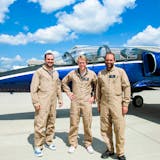The early-evening air is soft and warm on my skin as we march through a sea of calf-high grasses. It's just under 5 miles to our night's campsite at Portage Brook, an easy trek with June's long-lasting light. I'm dreaming of the freeze-dried lasagna on tonight's dinner menu when a cry rings out.
"Ticks!" yells Tom Lakner, one of my two companions and our lead hiker. Tom's 6-foot frame is bent toward the ground as he vigorously swats at his legs, clad in tan hiking pants. "There are dozens of them on me!"
Keith Myrmel, my other hiking partner, inspects his own pant legs and flicks a few ticks back into the grass. My legs are tick-free.
We continue along, Tom still in the lead. Not five minutes later, he abruptly stops. "There are dozens more on me again!" says Tom, a Columbus, Minn., resident, resuming his slapping and smacking. Keith discovers several on his pants; my tick count remains zero.
"Having someone else lead is my trick," whispers Keith, of Arden Hills. "The first person gets all the spider webs and ticks on them."
Thankful to be bringing up the rear, I stay tucked behind the men. That night, as Tom continues to flick ticks off his body, albeit from the comfort of his hammock, I'm snugged in my tent, eager to begin discovering the beauty that awaits.
A trail undiscovered
Tom, Keith and I are hiking the Border Route Trail, or BRT, a 65-mile path that winds through the Boundary Waters Canoe Area Wilderness (BWCA). The Minnesota Rovers outdoors club began building the trail in 1971 to showcase the dramatic and rugged topography looming over the picturesque chain of lakes that separates Minnesota from Ontario, Canada. Ten years later, the largely completed path became the state's first long-distance hiking trail created by volunteers.
Although the BRT begins at the northern terminus of the über-popular Superior Hiking Trail and traverses the legendary Boundary Waters — the most-visited wilderness area in the nation — few people realize it's here or use it. Brian Hanson, president of the Border Route Trail Association, which coordinates maintenance along the BRT, says the main reason the trail is overlooked is its lack of accessibility.


